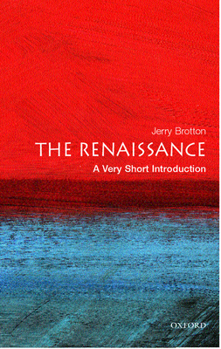The Renaissance: A Very Short Introduction
(Part of the Very Short Introductions (#148) Series and Oxford's Very Short Introductions series Series)
Select Format
Select Condition 
Book Overview
More than ever before, the Renaissance stands out as one of the defining moments in world history. Between 1400 and 1600, European perceptions of society, culture, politics and even humanity itself emerged in ways that continue to affect not only Europe but the entire world.
In this wide-ranging exploration of the Renaissance, Jerry Brotton shows the period as a time of unprecedented intellectual excitement, cultural experimentation, and interaction...
Format:Paperback
Language:English
ISBN:0192801635
ISBN13:9780192801630
Release Date:June 2006
Publisher:Oxford University Press, USA
Length:160 Pages
Weight:0.05 lbs.
Dimensions:0.4" x 5.1" x 6.7"
Customer Reviews
2 ratings
Engaging Introduction to The Renaissance
Published by Thriftbooks.com User , 16 years ago
Jerry Brotton's "The Renaissance: A Very Short Introduction" commences by using an interesting literary device to capture and focus the reader's attention: the Renaissance is introduced to us via the examination of one of the most famous pieces of artwork of the time, Han's Holbien's "The Ambassadors." This painting, which was completed about 1533, but not discovered until sometime in the 19th century, is a cornucopia of visual Renaissance imagery that illuminates our subject in a way that a standard written introduction alone might have trouble achieving. By using this painting not as a visual prop but as a focal point of discussion, the subject is made open to the reader in an appealing and stimulating manner. And once we are on our way, we find it difficult to stop, because Brotton's treatment of the subject is fully engaging while providing the important facts, issues, and mindsets of the period. This approach, along with the author's obvious talent in concise writing, makes the text a wonderful addition to Oxford's "Very Short Introduction" Series. After examining the Holbien painting, the author turns our focus to a second painting which helps us further explorer our subject with this same type of approach: Gentile and Bellini's "Saint Mark Preaching in Alexandria." From this work, also a masterpiece of the period, we are introduced to the subjects of Renaissance finance and financial issues, the increase of trade in volume and scope, introduction to new cultural contacts, the impact external culture had on Europe, and more. So, whereas the first painting by Holbien introduces the reader to main concepts of the period, the second, the Bellini work, helps us understand the changes that occurred in the period as a result of outside contact. It's an effective literary tool, and Brotton uses it deftly throughout the remainder of the work, where additional artwork is examined as needed until the end of the text. Once this setting and background is established, Brotton commences a treatment of the major themes of the Renaissance, and takes enough time to discuss the basic elements of each while, astonishingly, keeping the text length within the boundaries of the "Very Short Introduction" Series. We look into the development of the printing press and its role in spreading the new humanism, the differences between humanism and medieval scholasticism, and more. The ability of the printing press to spread humanistic thought in a way not previously possible is discussed in detail, as is the effect of the printing press on men such as Luther, Erasmus, and Machiavelli. Subsequent chapters investigate the interplay between church and state (a major issue during the Renaissance), the exploration of the New World, and innovations in science and philosophy. Each of these themes is discussed with sufficient detail for the reader to walk away with a clear notion of why there is a separate period called "The Renaissance," and how that period uniquely differ
Post 9/11 interpretation.
Published by Thriftbooks.com User , 17 years ago
As with many recent accounts of the renaissance, this little book spends a large number of its compact pages questioning the very term itself. In fact, at one point, Mr Brotton seemed to be in danger of defining it as the period in history which subsequent generations have uniquely defined for their particular needs. But don't stop reading, this book does in the end convey, and in one sitting, the revolutionary and extraordinary nature of this epoch, even if it does try sometimes too hard to provide a liberally pleasing post 9/11 interpretation. We learn far more of Arabic contribution to the birth of modernity than that of Michelangelo or Botticelli, however, the persistent hammer of the argument does, inevitably, start to feel persuasive. One is not allowed either, to come away from the book without having any romantic notions of the renaissance hugely diminished. It would appear that we escaped from the dismal religious claustrophobia of the medieval world through rising social inequality, the megalomania of ruthless tyrants, ruthless professional ambition together with the expedient needs of warfare, trade, and ultimately, African slavery and the rape of the America's. Strangely, Brotton is a little more perfunctory when it comes to his gender studies duties, merely contenting himself to point out that though the renaissance brought about the Copernican revolution in regards to how man saw his place in the world, renaissance man still saw women's place to be in the home. The book is not in the form of a continuous narrative, but instead devotes each chapter to a particular theme such as the darker side of the renaissance or renaissance literature. Brotton is particularly good in detailing the tremendous influence of the invention of printing in spreading knowledge and the new learning, and consequently bringing about massive social changes. He points teasingly to a comparison with the internet, though it is left to the reader to wonder if the new information revolution will lead to a new renaissance or to something truly darker.





